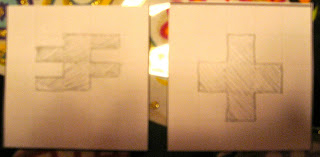I launched the explanation that it would be sort of like War, but comparing area instead. I showed them these two cards:
And asked which had the larger area. Unanimously the class agreed on the one on the right. What is the area? And someone explained how they got 3. "Do you agree or disagree?" Loud agreement. On to:
Students disagreed about which was bigger here, so we counted carefully. Finally all agreed that the cross was bigger.
The last set took a little longer to count, and then had a tie. The students knew that in War you play more cards and then compare. I described how we have a small deck, so for our ties we'd just play one more card, and then highest perimeter wins the tie breaker.
We talked about how in this game you make your own deck, but it had to have one card each with areas 1 square up to 9 squares, and then they could make two free cards however they wanted.
We then explained the full rules of the game. Each team draws two cards - always keep two cards in your hand. Then the team who's turn it is picks a card and declares 'high' or 'low' - whether the highest or lowest area will win this turn. The other team picks a card to play and the cards are revealed. The winner takes both cards. If it's a tie, each tied team plays another card, and highest perimeter wins. The next team takes a turn going first. Play until at least one team has played all its cards. The team that won the most cards wins.
 Students did a great job working in teams of two to creae a variety of interesting shapes. We chose the restriction that shapes had to be made of squares and half squares, or half rectangles. Once they had a deck check (1 to 9 + 2), they were free to find a team to battle. there were some rule clarifications to clear up, and a couple people got too competitive, but they really gave it a go. One group played a three team game and that went well, too. After playing they came back together to discuss strategy. They liked having a variety of cards, that hit both high and low. They talked about recognizing a neat idea from another team and then using it. One team started out with a 1/2 square area card but several had them by the end. Universal thumbs up as to whether they would recommend it to other teachers. They were requesting time to play in class later, which is surely a good sign.
Students did a great job working in teams of two to creae a variety of interesting shapes. We chose the restriction that shapes had to be made of squares and half squares, or half rectangles. Once they had a deck check (1 to 9 + 2), they were free to find a team to battle. there were some rule clarifications to clear up, and a couple people got too competitive, but they really gave it a go. One group played a three team game and that went well, too. After playing they came back together to discuss strategy. They liked having a variety of cards, that hit both high and low. They talked about recognizing a neat idea from another team and then using it. One team started out with a 1/2 square area card but several had them by the end. Universal thumbs up as to whether they would recommend it to other teachers. They were requesting time to play in class later, which is surely a good sign. Below are some images of student cards, and then a link to the handout if you want it.
Below are some images of student cards, and then a link to the handout if you want it.















Looks like a lot of fun! I'll have to give this a try with my math club, whenever we get back together.
ReplyDeleteThanks! This is just what I needed for my 5th graders!!
ReplyDeleteI have a question. How did 5th grade students count perimeter on shapes that had a diagonal? If the unit is 1, then the diagonal is square root of 2. Just wondering...
ReplyDeleteWe discussed how those edges were longer. They estimated them to be about 1 and a half and counted them that way. The teacher is a referee, and they can call a judge if needed. They were quite good at figuring it out, and were surprised how shapes with the same area can have radically different perimeters. "It's not even close!"
ReplyDelete